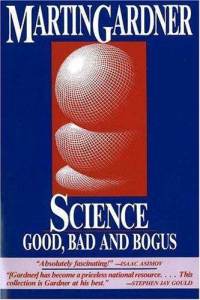From the Village Voice (June 1, 1982). — J.R.
SCIENCE: GOOD, BAD AND BOGUS by Martin Gardner. Prometheus, $18.95.
As an old fan of Fads and Fallcies in the name of Science, Martin Gardner’s classic ’50s “study in human gullibility,” I’ve been looking forward to a sequel for quite some time. This collection of 38 skeptical pieces about “pseudoscience” (from Uri Geller to UFOs, by way of ESP) and “eccentric fringes” (such as black holes, catastrophe theory, and talking apes) isn’t that sequel, but it’s the next best thing — an elegant paste-up of articles and book reviews Gardner has written over the past three decades.
Fads and Fallacies took up a veritable rogues’ gallery of cranks, bumblers, and hustlers through the ages — like Wilbur Gleen Voliva, who thought the earth was shaped like a pancake, or Colonel Dinshah Ghadiali, whose Spectro-Chrome Therapy prescribed colored lights and a proper diet for every ailment. Thanks to the warm amusement of the man who brought us The Annotated Alice, these characters were often imbued with a certain Gogolian density even as Gardner dispassionately tore their science to shreds. Faced with his less humorous contemporaries in Science: Good, Bad and Bogus, Gardner has to forgo much of this novelistic bent — an aesthetic loss, in some ways, but also a practical gain. His first book’s wide appeal was, after all, based on a partial misunderstanding. It became something of a best seller after repeated attacks from Long John Nebel’s radio show. Alas, at least one ’60s acquaintance of mine first became attracted to Scientology, irrationally and irresistibly, only after he had read Gardner’s hatchet job on its predecessor, Dianetics.
That kind of backfire effect doesn’t seem possible here. Apart from a few light enchantments, Gardner’s tone in this book tends to be steadier, sterner, meaner. This time he is playing for keeps. An accomplished amateur conjurer who repeatedly insists that professional magicians be brought along to observe alleged miracles, he goes after Uri Geller with an intellectual macho that is both ferocious and effective. To expose Geller’s tricks, he has even written two pseudonymous booklets (he is reluctant to divulge too many trade secrets) under the boastful badge of “Uri’s chief rival, Urian Fuller”.
In a witty footnote to one piece, Gardner recommends these booklets and then “speculates” on the multiple reasons for the pseudonym — reasons that include “Uriah Heep, the hypocrite in David Copperfield” and “Brother Willard Fuller, an evangelist who specializes in using prayer to to miraculously put gold, silver, and porcelain fillings in teeth.” Usually, though, Gardner is more interested in heaping useful scorn and sarcasm on his targets than in hawking any wares of his own. His paraphrase of EST is characteristic: “The whole idea of making it,” Erhard told [Adam] Smith, “is bullshit. In fact, everything is bullshit, including EST. Once you recognize this great truth, and that there is nothing to get, you ‘get it’. You lose, of course, your $250 initiation fee. That’s what EST gets.” What you get from Gardner, in contrast, is the pleasure, security (and intermittent monotony) of plain common sense.
— Jonathan Rosenbaum



